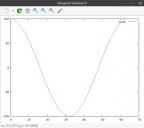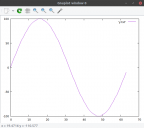Signalprocessing with fastspin (C) and P2
 Reinhard
Posts: 489
Reinhard
Posts: 489
in Propeller 2
hello forum
I am currently working on a library for digital signal processing on the P2. I just implemented a Hilbert transformation. You always need it when you have a real signal (I) and use it to generate component (Q) to get a so-called IQ signal.
It is also possible with a filter, but the phase shift is exactly 90 degrees only at a certain frequency with little effort. That's why I use the Cordic unit, do a Fourier transform on the real signal, move in Hilbert space and do an inverse transformation of it.
The FT is easy, a real number must be multiplied by the rotation factors. At IFT you have to do a bit of trickery.
The existing structures of propeller2.h could have been used for the implementation. No big difference.
In the appendix the input signal x and the output y.





Comments
LINE 93 in complex_test.c must change
from
y[k] += a * c + b * d; // this give x = cos y = sin
to
y[k] += a * c - b * d;// x = cos y = -sin this is math. correct
I make the multiplication of 2 complex numbers on notice paper
(a + ib) * (c + id) =
ac + iad +ibc - bd =
ac - bd + i(ad +bc)
we use the real part ac - bd
I do it right on paper and make a tipo in coding, what give sin instead -sin.
DPSK demodulation is exactly what I want to do with the P2 when the present project is finis.
the hilbert transformator in current state is more or less academical.
I do it for demonstration some dsp - functions.
hilbert is usefull if you have no knowledge about the signal.
You can easier generate a IQ pair, if you know the parameters.
Maybe for DPSK demod is this thread for interesst.
https://forums.parallax.com/discussion/170987/simple-iq-modulation-with-cordic-finished#latest
(But this was my first try with the processor and the programming language)
the hilbert transformation was really just a test for my dsp - lib.
For filter it is better to work in the time domain.
Give me a little time and I will give you examples of filters in the time domain (lowpass, highpass, bandpass, notch, etc.)
Sure, that sounds great!1. It would be fun to make a Graphics EQ with the P2.
First you need a program, that calculate the filter coeffiecents for you.
I have a program, that calculate a biquad filter.
The name is BQ.c
Under Linux it is compile with gcc -o BQ BQ.c -lm
(under window or mac it must be similar)
if you run BQ without parameters you get ;
./BQ
usage:
./BQ filtertype Fc Q peakGaindB
filtertype
0 ... LowPass
1 ... HighPass
2 ... BandPass
3 ... Notch
4 ... Peak
Fc = fcut/fsample
Q = Quality of the filter
The higher the quality, the steeper the filter
peakGain = peakGain in dB
example for LowPass: 0 0.25 1 0
you want a bandpass:
./BQ 2 0.25 1 0
you get ;
#define a0 0.333333
#define a1 0.000000
#define a2 -0.333333
#define b1 -0.000000
#define b2 0.333333
this are the filter coefficients, more to use it later.
if you have gnuplot, you can visualize
#! /bin/bash
gnuplot -p -e 'plot "Amplitude.txt" with lines'
gnuplot -p -e 'plot "Phase.txt" with lines'
gnuplot -p -e 'plot "Nyquist.txt" with lines'
gnuplot -p -e 'plot "Impulsresponse.txt" with lines'
I'm looking for examples for P2, but calculate the filter coefficients is the basic.